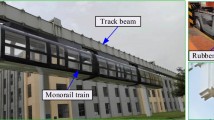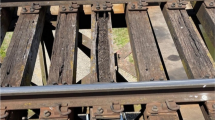Abstract
This article deals with the dynamic analysis of train–track–bridge interaction system using the finite element method. In this interaction system, each four-wheelset vehicle in the train is modeled by a mass–spring–damper system with 10 degrees of freedom; the rails and the bridge decks are modeled as a number of Bernoulli–Euler beam elements, while the elasticity and damping properties of the rail bed are represented by continuous springs and dampers. The equation of motion for the interaction system is presented in matrix form with time-dependent coefficients. The correctness of the proposed procedure is illustrated by a comparison with the numerical result from the existing literature. Several numerical examples are chosen to investigate the effect of two types of vehicle models, two types of bridge models and three damping values of bridge on the maximum dynamic responses of train, track and bridges.
Similar content being viewed by others
References
Au F.T.K., Cheng Y.S. and Cheung Y.K. (2001). Vibration analysis of bridges under moving vehicles and trains: an overview. Prog. Struct. Eng. Mater. 3(3): 299–304
Au F.T.K., Wang J.J. and Cheung Y.K. (2001). Impact study of cable-stayed bridge under railway traffic using various models. J. Sound Vib. 240(3): 447–465
Bathe K.J. and Wilson E.L. (1976). Numerical Methods in Finite Element Analysis. Prentice-Hall, Englewood Cliffs
Chatterjee P.K., Datta T.K. and Surana C.S. (1994). Vibration of continuous bridges under moving vehicles. J. Sound Vib. 169(5): 619–632
Cheng Y.S., Au F.T.K. and Cheung Y.K. (2001). Vibration of railway bridges under a moving train by using bridge-track-vehicle element. Eng. Struct. 23(12): 1597–1606
Cheung Y.K., Au F.T.K., Zheng D.Y. and Cheng Y.S. (1999). Vibration of multi-span non-uniform bridges under moving vehicles and trains by using modified beam vibration functions. J. Sound Vib. 228(3): 611–628
Chu K.H., Garg V.K. and Wang T.L. (1986). Impact in railway prestressed concrete bridges. J. Struct. Eng. (ASCE) 112(5): 1036–1051
Frýba L. (1996). Dynamics of Railway Bridges. Thomas Telford, London, 67–77
Frýba L. (2001). A rough assessment of railway bridges for high speed trains. Eng. Struct. 23(5): 548–556
Henchi K., Fafard M., Dhatt G. and Talbot M. (1997). Dynamic behaviour of multi-span beams under moving loads. J. Sound Vibr. 199(1): 33–50
Ichikawa M., Miyakawa Y. and Matsuda A. (2000). Vibration analysis of the continuous beam subjected to a moving mass. J. Sound Vib. 230(3): 493–506
Kortuem W. and Wormley D.N. (1981). Dynamic Interactions between Travelling Vehicles and Guideway Systems. Veh. Syst. Dyn. 10(4–5): 285–317
Le, R., Ripke, B., Zacher, M.: Ballast mats on high speed bridges. In: Proceedings of the Fourth European Conference on Structural Dynamics, EURODYN’99, Prague (Czech Republic), pp. 699–703 (1999)
Li J. and Su M. (1999). The resonant vibration for a simply supported girder bridge under high-speed trains. J. Sound Vib. 224(5): 897–915
Lou P. (2005). A vehicle-track-bridge interaction element considering vehicle’s pitching effect. Finite Elem. Anal. Des. 41(4): 397–427
Lou P. (2005). Vertical dynamic responses of a simply supported bridge subjected to a moving train with two-wheelset vehicles using modal analysis method. Int. J. Numer. Methods Eng. 64(9): 1207–1235
Lou P. (2006). Comparison of two types of deflection functions for analyzing the responses of the rail and the bridge under static or moving vehicles. Proc. Inst. Mech. Eng. K J. Multibody Dyn. 220(2): 105–123
Lou P., Dai G.L. and Zeng Q.Y. (2005). Modal coordinate formulations for a simply supported bridge subjected to a moving train modelled as two-stage suspension vehicles. Proc. Inst. Mech. Eng. C J. Mech. Eng. Sci. 219(10): 1027–1040
Lou P. and Zeng Q.Y. (2005). Formulation of equations of motion of finite element form for vehicle-track-bridge interaction system with two types of vehicle model. Int. J. Numer. Methods Eng. 62(3): 435–474
Lou P. and Zeng Q.Y. (2005). Finite element based formulations for vehicle–bridge interaction system considering vertical motion. J. Struct. Eng. 32(4): 261–273
Newmark N.M. (1959). A method of computation for structural dynamics. J. Eng. Mech. Div. (ASCE) 85(3): 67–94
Olsson M. (1985). Finite element, modal co-ordinate analysis of structures subjected to moving loads. J. Sound Vib. 99(1): 1–12
Paz M. (1989). Modified dynamic condensation method. J. Struct. Eng. (ASCE) 115(1): 234–238
Wang T.L., Garg V.K. and Chu K.H. (1991). Railway bridge/vehicle interaction studies with new vehicle model. J. Struct. Eng. (ASCE) 117(7): 2099–2116
Wiriyachai A., Chu K.H. and Garg V.K. (1982). Bridge impact due to wheel and track irregularities. J. Eng. Mech. (ASCE) 108(4): 648–666
Wu Y.S. and Yang Y.B. (2003). Steady-state response and riding comfort of trains moving over a series of simply supported bridges. Eng. Struct. 25(2): 251–265
Yang Y.B., Chang C.H. and Yau J.D. (1999). An element for analyzing vehicle-bridge systems considering vehicle’s pitching effect. Int. J. Numer. Methods Eng. 46(7): 1031–1047
Yang Y.B. and Lin B.H. (1995). Vehicle-bridge interaction analysis by dynamic condensation method. J. Struct. Eng. (ASCE) 121(11): 1636–1643
Yang Y.B. and Yau J.D. (1997). Vehicle-bridge interaction element for dynamic analysis. J. Struct. Eng.(ASCE) 123(11): 1512–1518
Yang Y.B., Yau J.D. and Hsu L.C. (1997). Vibration of simple beams due to trains moving at high speeds. Eng. Struct. 19(11): 936–944
Yau J.D., Yang Y.B. and Kuo S.R. (1999). Impact response of high speed rail bridges and riding comfort of rail cars. Eng. Struct. 21(9): 836–844
Zeng Q.Y. (2001). The principle of a stationary value of total potential energy of dynamic system(in Chinese). J. Huazhong Univ. Sci. Technol. 28(1): 1–3
Zeng Q.Y. and Guo X.R. (1999). Theory and Application of Vibration Analysis of Train-Bridge Time-Dependent System. China Railway Publishing House, Beijing, 15–48
Author information
Authors and Affiliations
Corresponding author
Rights and permissions
About this article
Cite this article
Lou, P. Finite element analysis for train–track–bridge interaction system. Arch Appl Mech 77, 707–728 (2007). https://doi.org/10.1007/s00419-007-0122-4
Received:
Accepted:
Published:
Issue Date:
DOI: https://doi.org/10.1007/s00419-007-0122-4




